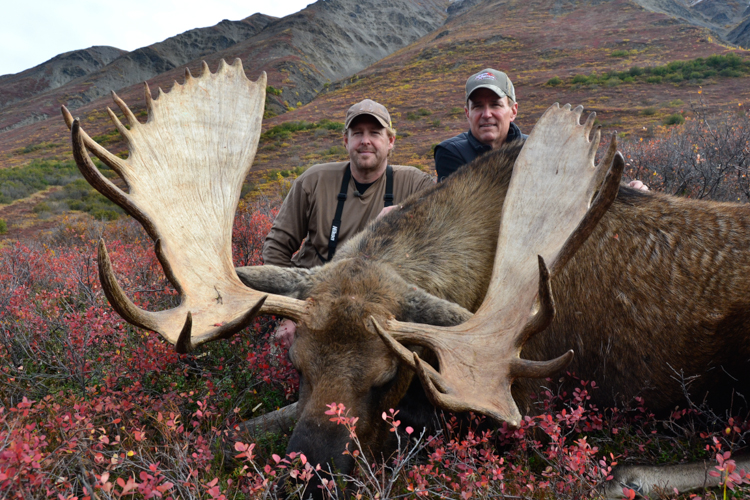Put Your Odds On A Trophy Moose
I haven’t hunted moose in 2 years, but I am scheduled to go back to the Alaska Range this September in search of a 60”+ bull.
On my last hunt to the same location, I took a great bull of some 58” and was with a friend who took another fantastic moose. My 2 other camp mates scored on true B&C monsters; one was 65” wide and the other was an unbelievable 76”. I measured them myself, and though I am not a tape guy, it was incredible to know just how wide these two brutes truly were.

I have been on 3 moose hunts, and I have taken 3 trophy bulls. This is not due to me being some standout moose hunter, I assure you. I have learned over the years that there are a few things you can do to tip the scales in your favor when it comes to success, and they really can make or break your hunt.
First, you must pick an area that has a good moose population and has a proven track record of producing the caliber of bulls you are looking for. If you are hunting Canada moose in British Columbia, look for areas that average bulls over 50 inches. If you are hunting in the Yukon or Alaska, the magic number is 60”, but any area or outfit that averages bulls in the high 50’s” has quality animals.
Do some research – talk to others who have hunted the areas, etc. You can’t kill a big bull in areas that are hunted hard by a lot of people. Bulls in these areas just do not get to live to an age where they can reach their genetic potential, and if you are looking for a true trophy, they are a waste of time.
Secondly, get in shape. Moose often live in very remote and rugged country, and they have a much easier time traversing that harsh terrain with their long powerful legs than do we humans. That last hunt of mine in Alaska was as tough physically as the mountain goat hunt I had done a couple of years before. I was in pretty decent shape and got it done, but after struggling to keep up with my guide every day, I vowed that I would be in even better shape on my next moose trip.
Not only will being in the best shape you can help you get to where you need to be in pursuit of moose, it will also make the trip much more enjoyable. If you hunt for a week or ten days in the mountains or swampy areas that moose call home, and walking a few miles a day takes a real toll on you, you are not going to remember your moose hunting experience as being fun. If you are in good shape, you will not struggle, and you can enjoy the surroundings, you can concentrate more on the task at hand, and if you have to get to a tough spot or make a move in a hurry to get a shot, you will be able to do that. I have dropped 45 pounds over the past few months, and I am looking forward to the challenges of Alaska this fall. If I had of gone on the hunt last year, I would have honestly been miserable.
Lastly, learn to shoot. I live in the eastern US, and a 200-yard shot at a whitetail is considered a long one in my neck of the woods. On my last moose hunt, I was lucky and shot my bull at 238 ranged-yards, and on a target that weighs 1500 pounds, it wasn’t very difficult.
What I did witness was my hunting companion taking his bull that showed me how shooting practice will pay off in a huge way. On the first day of our hunt we glassed a mountainside and could see 4 different bull moose and a number of cows. It took us a couple of hours to hike into the area where we thought the best bull was, and when we got there, we experienced one of the most memorable hours of my hunting career
In a small meadow and the surrounding brush, there were 3 bulls and 4 cows literally running in every direction. The bulls were chasing cows, grunting and occasionally squaring off on each other. This was the moose rut at its absolute peak, and the action was so fast and furious, that we had a hard time deciding which was the best bull, and once we did, we could not get a shot even though the bull was inside 150 yards on two occasions.
Finally the wind shifted, and old cow got a huge nose full of our scent, and the party was over. As we looked at each other in dejected disbelief, I looked way up the mountain and saw a cow trot out into the open, and the big bull was right behind her.
They stopped and looked down on us from way out of my comfortable range. I was admiring the bull through my binos and was enjoying the scene, when the crack of my friend’s rifle almost gave me a heart attack. I looked over at him 20 yards away, and he gave me a thumbs up along with a big grin. I looked back at the moose just in time to see it topple and fall right there. I couldn’t believe my eyes, so I got out my range finder and hit the cow standing over her downed suitor. The reading was 543 yards, and all I could do was hake my head.
I asked my friend, “What just happened?”, and he explained to me that he had 100% confidence that he could take the bull cleanly at that distance, so he shot. He is a ballistic guru, and told me he was shooting Winchester 180 grain Accubond CTs out of his favorite .300 Win., and he had practiced all summer out to 750 yards. He is lucky to live on a farm where he can practice like that, but it definitely showed me that the farther that you can shoot accurately, the better your odds are of bagging a trophy moose.
He went on to explain that he had taken many elk over the years on late season hunts with the 180-grain Accubond CT’s at distances from 250 to 600 yards, and he knew the performance was there both for accuracy and performance once at target. This load is a true flat shooter at 3010 fps, and the Accubond CT’s combine the best of knock down power, deep penetration and controlled expansion that are just the ticket on moose or elk.
If you are planning a moose hunt in the future, I highly recommend that you begin preparing well in advance. Do your homework on hunting locations, get in shape, and practice a lot at the rifle range leading up to your hunt. If you keep these three things in mind and put your time in, you will have a successful hunt that you will truly enjoy and remember fondly for the rest of your days.




